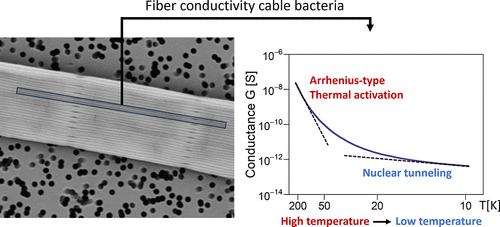Temperature-Dependent Characterization of Long-Range Conduction in Conductive Protein Fibers of Cable Bacteria
IF 15.8
1区 材料科学
Q1 CHEMISTRY, MULTIDISCIPLINARY
引用次数: 0
Abstract
Multicellular cable bacteria display an exceptional form of biological conduction, channeling electric currents across centimeter distances through a regular network of protein fibers embedded in the cell envelope. The fiber conductivity is among the highest recorded for biomaterials, but the underlying mechanism of electron transport remains elusive. Here, we performed detailed characterization of the conductance from room temperature down to liquid helium temperature to attain insight into the mechanism of long-range conduction. A consistent behavior is seen within and across individual filaments. The conductance near room temperature reveals thermally activated behavior, yet with a low activation energy. At cryogenic temperatures, the conductance at moderate electric fields becomes virtually independent of temperature, suggesting that quantum vibrations couple to the charge transport through nuclear tunneling. Our data support an incoherent multistep hopping model within parallel conduction channels with a low activation energy and high transfer efficiency between hopping sites. This model explains the capacity of cable bacteria to transport electrons across centimeter-scale distances, thus illustrating how electric currents can be guided through extremely long supramolecular protein structures.

电缆细菌导电蛋白纤维长距离传导的温度特性分析
多细胞缆索细菌显示出一种特殊的生物传导形式,它通过嵌入细胞包膜的规则蛋白质纤维网络将电流传导到几厘米远的地方。这种纤维的电导率是生物材料中最高的,但其电子传输的基本机制仍然难以捉摸。在这里,我们对从室温到液氦温度的电导率进行了详细表征,以深入了解长程传导的机制。在单个灯丝内部和跨灯丝之间都可以看到一致的行为。室温附近的电导显示出热启动行为,但活化能较低。在低温条件下,中等电场下的电导率几乎与温度无关,这表明量子振动通过核隧道与电荷传输相耦合。我们的数据支持在平行传导通道内的非相干多步跳变模型,该模型具有低活化能和跳变点之间的高传输效率。这一模型解释了缆索细菌跨越厘米级距离传输电子的能力,从而说明了电流是如何通过极长的超分子蛋白质结构被引导的。
本文章由计算机程序翻译,如有差异,请以英文原文为准。
求助全文
约1分钟内获得全文
求助全文
来源期刊

ACS Nano
工程技术-材料科学:综合
CiteScore
26.00
自引率
4.10%
发文量
1627
审稿时长
1.7 months
期刊介绍:
ACS Nano, published monthly, serves as an international forum for comprehensive articles on nanoscience and nanotechnology research at the intersections of chemistry, biology, materials science, physics, and engineering. The journal fosters communication among scientists in these communities, facilitating collaboration, new research opportunities, and advancements through discoveries. ACS Nano covers synthesis, assembly, characterization, theory, and simulation of nanostructures, nanobiotechnology, nanofabrication, methods and tools for nanoscience and nanotechnology, and self- and directed-assembly. Alongside original research articles, it offers thorough reviews, perspectives on cutting-edge research, and discussions envisioning the future of nanoscience and nanotechnology.
 求助内容:
求助内容: 应助结果提醒方式:
应助结果提醒方式:


